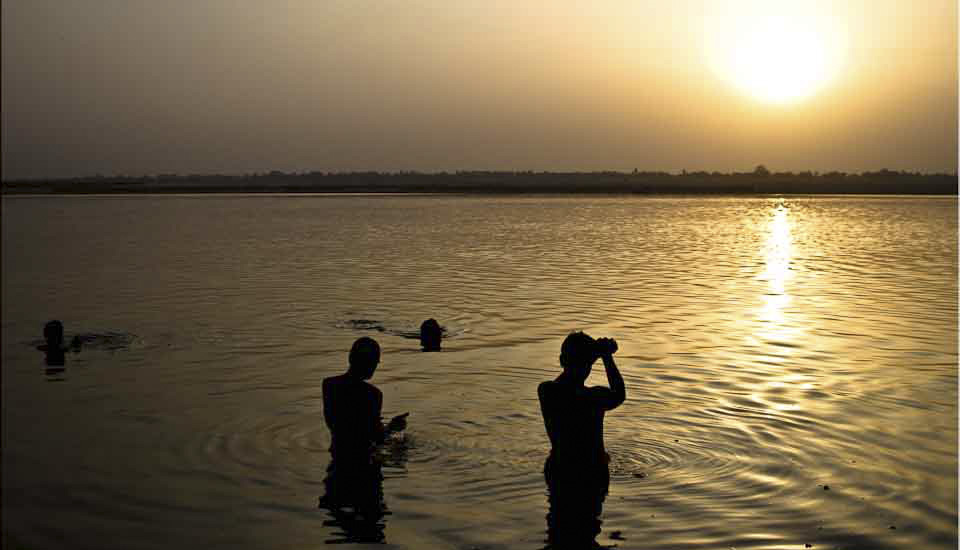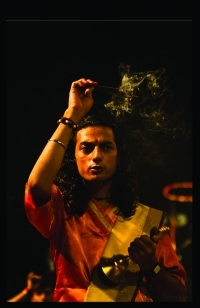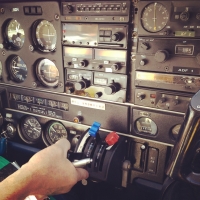.jpg)
In the Courtyard of the Shah-e-Hamadan Masjid
Reputedly sitting on the site of Kashmir’s oldest mosque, this distinctively spired iteration in the Old City of Srinagar was built in the 1730s. Constructed without any nails, it showcases the age-old Kashmiri craft of paper-mache decoration and the intricately-faceted wood-panelling known as khatamband.
Kashmir.
That fabled landscape of snow-capped mountains and lush valleys – once a princely state under the British Raj – has long been on my wish list.
Today, portions of the overall region are administered by China, India, and Pakistan, with the actual boundaries frequently in dispute. This often renders the area unsafe for tourists. As recently as April of this year, 26 people were killed in a popular tourist spot within the Indian-administered region, with Pakistani-nationals being blamed (see: BBC News: Pahalgam attackers).
I got lucky!
Back during a period of relative calm, I managed to find a small-group photography tour that was travelling to the region. We had arrived in Srinagar, the largest city and summer capital of the Indian-administered union territory of Jammu and Kashmir, the day before, and were staying in well-appointed houseboats on Dal Lake (see: Water, Dreams, and Woodwork).
The first stop on our first full day in the Old City of Srinagar was at the Khanqah-e-Moula, also known as – among other things and spellings – Shah-e-Hamadan Masjid and Khanqah. A Sunni mosque, it was originally commissioned by Sultan Sikandar Butshikan in 1395 in memory of the Islamic preacher Mir Sayyid (Syed) Ali Hamadani. Mir Sayyid Ali Hamadani (c. 1314–1384) was a Persian Sufi saint, scholar, poet, and missionary who is credited with spreading Islam across Kashmir and Central Asia. He also introduced Persian handicrafts to the region, laying the foundation for Kashmir’s carpet and textile industry.
The original building was destroyed by a fire in 1480, so what we see today mostly dates to 1731 – having been rebuilt again after yet another fire. Called Srinagar’s most beautiful mosque, it was reconstructed in the traditional manner, without any nails. All the surfaces, inside and out, are covered in papier-mâché (paper mache) reliefs and khatamband, elaborately intricate hand-crafted wooden pieces held together purely by their joinery – and all are wonderfully painted in colourful patterns.
As Non-Muslim visitors, we weren’t allowed into the building. We were permitted to peek through the front door and windows at the lavish interior. And, we could walk around the outside, appreciating the impressively complicated decorations.
Beyond the old wooden mosque, everyday life continues in the old city streets of Srinagar.
Come for a walk with me!
.jpg)
Still Life Found : Flowers on a Shikara
Early in the morning, one of Dal Lake’s distinctive wooden boats is waiting at our wharf, loaded with locally-grown flowers for sale. (iPhone12Pro)
.jpg)
A Lotus and a Kashmir Lily
The flower-seller generously gave me a couple of gorgeous blooms. (iPhone12Pro)

Textured and Peeling Wood
Taxi shakiras collect us, and we are transported over the waters, through the warren of wooden houseboats, and to the shores of the city itself.

A Butcher and his Hookah
As we walk towards the Khanqah Shah-i-Hamadan Muslim Pilgrim Hall, we pass what can only be called very informal markets!

Outside the Shah-e-Hamadan Masjid
The old city streets aren’t particularly busy, but there is a mix of foot traffic and two- three- and four wheeled vehicles.

Woman in White
Outside the mosque, old women sell bags of pigeon-food.

Man outside the Mosque

Pigeons in the Courtyard
In Islam, pigeons are associated with peace and safety. Feeding birds – and other animals – is considered sadaqah: a voluntary act of charity and kindness that pleases God and benefits others.

Water Break in the Mosque
Some work is being being done in the prayer hall; one of the workers lets me make his picture as he takes a break. (iPhone12Pro)

Papier-Mâché Colour and Khatamband Pattern
Intricate woodwork designs and vibrant papier-mâché colours are everywhere.

Door Pull

Inside the Shah-e-Hamadan Mosque
The mosque interior is ornate and elaborately patterned. Four solid wooden pillars nearly 7m (23 ft) in height support the ceiling. Each is decorated with painted wooden chips arranged in a fishbone pattern, carved lotus motifs at the base, and leaf designs in the capitals. (iPhone12Pro)

Woman with Bird Food
Many of the visitors to the mosque take time to feed the pigeons.

Decorated Exterior
These patterns reminded me of the ceramic tiles on the buildings in old Portuguese streets – but like the rest of the building, it is all painted wood and papier-mâché!

Ladies’ Entrance
At the back of the building, we find the women’s entrance. It is much smaller than the main front door – but no less decorated.

Over the Jhelum River
The mosque backs onto the main river through Srinagar; through the trees, we can just see the multi-story buildings on the other bank.

A Patch of Light

A Couple on the Steps
Back in the front courtyard, I meet a local couple who have come to feed the birds.

Tailor in his Shop
Outside the mosque, in the streets of Old Srinagar …

In the Narrow Streets
… the bustle of everyday life continues.

Tuk Tuk Corner

Man on a Stoop
I don’t see a lot of women in the street, but most of the men are happy to be photographed.

The Public Tap
Not all businesses or homes are connected to to piped water, so public water taps are critically important.

Local Man

Food Shop
In India, you are never far from freshly cooked food …

Man in a Food Shop
… and a welcoming smile – even when you are not buying anything.

Pigeons Overhead
Everywhere you look, there is colour and life!
Our walk through the ancient streets continued, through bustling markets and to the next old mosque.
More about that some other time!
 Until then,
Until then,
Happy Wandering!
Pictures: 11September2023
































.png)

